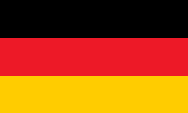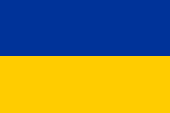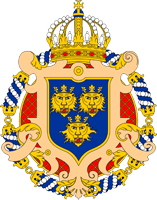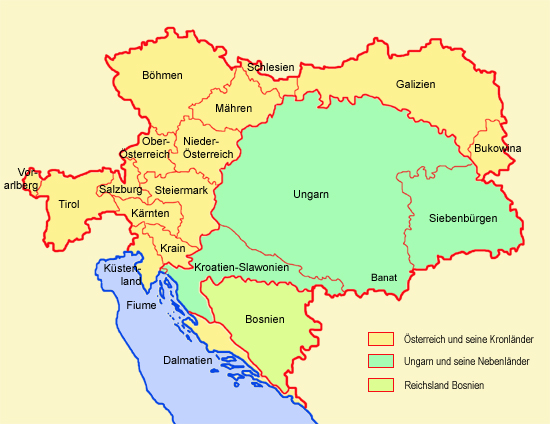mobile View, to the German Version tap the flag


- former Austrian crown land: Kingdom of Dalmatia
- today countryside of Croatia situated at the coast of the Adriatic Sea
- own name in German: Königreich Dalmatien
- own name in Croatian: Kraljevina Dalmacija
- own name in Italian: Regno di Dalmazia
• Flag
• Meaning/Origin of the Flag
• Coat of Arms
• Meaning/Origin of the Coat of Arms
• Map of the former crown lands of Austria-Hungary (to 1918)
• Numbers and Facts
• History
• Origin of the Country's Name

to 1918,
Flag of the country (Colours of the country),
ratio = 2:3,
Source, by:
Flags of the World





The country had – like all the other crown lands of the Austrian crown – its own colours (Landesfarben), which were used amongst others on horizontally two- or three-striped flags. The colours (Landesfarben) were very often taken from the respective coat of arms of the country or were supplemented by another colour, which not appears in the coat of arms, or they went back to older models of the coat of arms (e.g. Carniola). Officially, the colours had never been regulated or stipulated, so that their sequence varied in practice or even the colors deviated. The Austrian heraldist Hugo Gerard Ströhl (1851–1919) was probably the first to take care of it and asked for the colors (Landesfarben) on the flags at the respective state authorities around 1890 and compiled them. The Crown Land of Dalmatia used as colours of the country a flag which showed two horizontal stripes in blue and gold. The colours descend from the coat of arms of Dalmatia: three golden lion-heats on a blue shield. The the sequence of the colours is in this way heraldically not correct.
Source: Österreichisch-Ungarische Wappenrolle,
Flags of the World,
Volker Preuß


to 1918,
Coat of arms of Dalmatia,
Source, by: Ströhl, Wappenrolle Österreich-Ungarns, 1890, via austria-forum.org

ca.1890–1918,
Coat of arms of the Kingdom of Dalmatia,
Source, by: Ströhl, Wappenrolle Österreich-Ungarns, 1890, via Wikipedia (D)

Coat of arms of Kroatien,
Source, by: Wikipedia (D)

The coat of arms of Dalmatia shows three golden crowned lion-heats on a blue shield. The Austrian heraldist Hugo Gerard Ströhl surrounded the coat of arms around 1890 with a decorative border. The heraldry of Dalmatia appears since 1992 in one of the five regional scutcheons in the upper part of the coat of arms of Croatia, but the shield is pale blue.
Source: Österreichisch-Ungarische Wappenrolle,
Wikipedia (D),
Volker Preuß

Map ca. 1910:

Source: Volker Preuß

Area: 4.954 square miles (1880)
Inhabitants: 476.00 (1880), thereof 93% Croats and Serbs, 6% Italians, 0,7% Germans
Density of Population: 96 inh./sq.mi. (1880)
Capital: Split (Italian: Spalato), 14.500 inh. (1880)
Languages (1890): Serbian/Croatian, Italian, German
Currency: to 1918 Austro-Hungarian currency, since 1918 Yugoslav currency, since 1941 Croatian currency, since 1945 Yugoslav currency, since 1991 Croatian currency
Time Zone: GMT + 1 h
Source: Meyers Konversationslexikon,
Wikipedia (EN)

200 B.C. · the Dalmium City (near the today’s City of Split) is capital of the State of Dalmatia
168 B.C. · the Roman Empire conquers Dalmatia southern the Neretva River
156 B.C. · the Roman Empire conquers the coast of Dalmatia
78 B.C. · the conquest of Dalmatia by the Roman Empire is finished, however riotings and civil war
10 A.D. · the Roman control is consolidated, formation of the Province of Illyricum (today’s Dalmatia, Croatia, Herzegovina)
395 · at the partition of the Roman Empire Dalmatia comes to the West Roman Empire (Rome)
423 · death of the first West Roman Emperor Flavius Honorius, Dalmatia comes to the East Roman Empire (Byzantium)
454–468 · Dalmatia belongs to the Empire of Marcellinus
489–553 · Dalmatia belongs to Empire of the Eastern Goth
545–569 · Dalmatia belongs to the East Roman Empire (Byzantium)
569–598 · conquest by the Awars
ca. 620 · appropriation by immigrating Croats and Serbs
ca. 795 · the Croats (in the north of Dalmatia) become dependent from the Frankish Empire, the islands and some coastal towns remain at the East Roman Empire (Byzantium)
1052 · King Crescimir Peter from Croatia adopes the title "King of Dalmatia"
1150 · extinction of the "Kings of Dalmatia", was of succession between Hungary and Venice
1242 · invasion of the Mongols
1433 · armistice between Hungary and Venice, division of Dalamtia, the by Croatians inhabited parts come to Hungary, the leftovers to Venice
1462 · beginning invasions of the Turks, Venice is able to defend its possessions in Dalmatia successfully
21st of July 1718 · Peace of Passarowitz after the Turk Wars, Venice expands its possessions in Dalmatia to the today’s border boundary between Croatia and Bosnia
1797–1809 · French Revolutionar Wars, parts of Austria (Styria) become occupied by the French in 1797
2th of May 1797 · Peace of Campo Formio between Austria (House of Habsburg) and France (Napoléon I.), Dalmatia comes as a kingdom from Venice to the House of Habsburg
1809 · Peace of Vienna, Austria loses Salzburg, the Inn Quarter, Western Galicia and parts of Eastern Galicia and cedes Istria, Trieste, Gorizia, Carniola, Carinthia, Croatia, and Dalmatia to France, which were merged in 1810 to the French "Illyrian Provinces"
1813 · Austria declares war on France (Napoléon)
1814/1815 · Congress of Vienna, realignment of Europe after the era Napoléon, the Empire of Austria (House of Habsburg) acquires back the in 1809 lost territories; Istria, Trieste, Gorizia, Carinthia and Carniola become merged to the Habsburg's Kingdom of Illyria, Dalmatia and Croatia become re-annexed to Hungary (under the Habsburgs, part of the Empire of Austria)
1848/1849 · revolution in Vienna, civil war between Hungarians and Croats, riotings in Prague, Mailand and Venice, as a result of that Emperor Ferdinand I. resigns and Franz Joseph I. of Habsburg becomes new Emperor, the riotings become suppressed and he enacts a new constitution: the titular hereditary territories of the Habsburgs in the Austrian Empire become converted to crown lands with their own Landtag (parliament), the Landtag of Dalmatia rejects the annexion to Croatia, the Kingdom of Dalmatia becomes an own crown land of the Austrian crown, Croatia and Slavonia become united to the "Croatia and Slavonia", which remains as a subsidiary country under the Hungarian crown, dissolution of the Kingdom of Illyria: division in the crown lands of Carniola, Carinthia, Littoral, Croatia and Slavonia and Dalmatia
1861 · demands of the Slavs in Dalmatia for formation of an "Triune Kingdom" out of Croatia, Slavonia and Dalmatia (including Bosnia and Herzegovina)
8th of February in 1867 · Austro-Hungarian Compromise, equal rights for both parts of the empire, nascence of the double monarchy of Austria-Hungary, Austria: consisting of the Austrian crown lands, Hungary: consisting of Hungary itself and its subsidiary countries, the House of Habsburg sets in one person the Emperor of Austria and the King of Hungary, establishment of common ministries in foreign affairs, finance and defense
1868 · Hungarian-Croatian Compromise, Croatia and Slavonia remain together as the Kingdom of "Croatia-Slavonia" under the Hungarian crown, Fiume becomes a free city (quasi crown land) within Hungary
1869 · revolt in Càttaro (Kotor)
1878 · Austria-Hungary occupies Bosnia and Herzegovina
1881 · once more revolt in Càttaro (Kotor)
1918 · end of the First World War, breakdown of the imperial-royal monarchy, disintegration of Austria-Hungary in national states, Dalmatia and Slavonia come to Croatia, unification of Croatia, Slovenia, Serbia and Montenegro to the "Kingdom of the Serbs, Croats and Slovenes" (since 1929 named Yugoslavia)
Source: Atlas zur Geschichte,
Wikipedia (D),
RetroBib Retrobibliothek,
Discovery '97,
Volker Preuß

The name "Dalmatia" has its roots in the antique town of "Dalmium" (also named "Delminium") near of the today’s Split City. In the word itself is hidden the Illyrian word "dhal" what means "sheep".
Source: Meyers Konversationslexikon,
Indogermanisches Etymologisches Woerterbuch

Further Austria pages (historical flags and coats of arms):
• Empire of the Austrian Habsburgs (to 1804)
• Empire of Austria (1814–1867)
• Austria-Hungary (1867–1918)
• Republic of Austria (since 1918)

![]()








